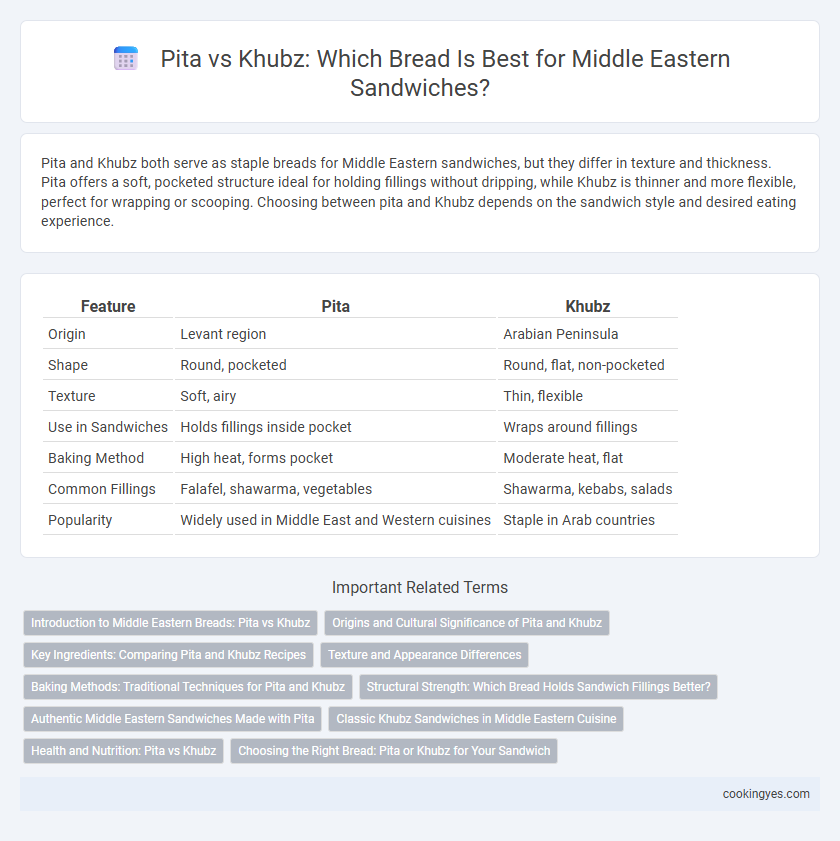Pita and Khubz both serve as staple breads for Middle Eastern sandwiches, but they differ in texture and thickness. Pita offers a soft, pocketed structure ideal for holding fillings without dripping, while Khubz is thinner and more flexible, perfect for wrapping or scooping. Choosing between pita and Khubz depends on the sandwich style and desired eating experience.
Table of Comparison
| Feature | Pita | Khubz |
|---|---|---|
| Origin | Levant region | Arabian Peninsula |
| Shape | Round, pocketed | Round, flat, non-pocketed |
| Texture | Soft, airy | Thin, flexible |
| Use in Sandwiches | Holds fillings inside pocket | Wraps around fillings |
| Baking Method | High heat, forms pocket | Moderate heat, flat |
| Common Fillings | Falafel, shawarma, vegetables | Shawarma, kebabs, salads |
| Popularity | Widely used in Middle East and Western cuisines | Staple in Arab countries |
Introduction to Middle Eastern Breads: Pita vs Khubz
Pita and Khubz represent two staple Middle Eastern breads essential for authentic sandwich experiences, each offering unique textures and flavors. Pita features a soft, pocketed structure perfect for stuffing with various fillings, while Khubz is a thin, flat loaf commonly used to scoop dips or wrap ingredients. Understanding the differences between Pita and Khubz enhances appreciation of Middle Eastern culinary traditions and their diverse bread applications.
Origins and Cultural Significance of Pita and Khubz
Pita, originating from the Levant region, is a round, pocketed flatbread integral to Middle Eastern cuisine, often used for sandwiches like falafel and shawarma. Khubz, also known as Arabic bread, is a thinner, larger flatbread commonly baked fresh daily across the Arab world, serving as a staple accompaniment to meals. Both breads hold deep cultural significance, with pita symbolizing the Levantine heritage and khubz embodying the broader Arab culinary tradition and communal dining practices.
Key Ingredients: Comparing Pita and Khubz Recipes
Pita and Khubz, both staples of Middle Eastern cuisine, differ primarily in their key ingredients and preparation methods. Pita dough typically includes yeast, flour, water, and salt, creating a soft, pocketed bread that puffs up during baking. Khubz, or Arabic flatbread, features flour, water, salt, and sometimes semolina, resulting in a thinner, denser texture without a pocket, ideal for wrapping or scooping traditional fillings.
Texture and Appearance Differences
Pita bread features a soft, pocketed texture ideal for holding fillings, while Khubz presents a thinner, denser consistency without a pocket, often used to wrap ingredients. Pita's round, puffed appearance contrasts with Khubz's larger, flatter, and sometimes slightly chewy surface. These differences influence the overall sandwich experience in Middle Eastern cuisine, with pita offering convenience in stuffing and Khubz providing a more pliable wrap.
Baking Methods: Traditional Techniques for Pita and Khubz
Pita is traditionally baked in a high-temperature stone oven, causing the dough to rapidly puff and create a characteristic pocket essential for holding sandwich fillings. Khubz is baked on a flat surface like a saj or griddle, producing a thinner, softer bread without a pocket, often cooked at lower temperatures. These distinct baking methods influence texture, thickness, and suitability for different Middle Eastern sandwich styles.
Structural Strength: Which Bread Holds Sandwich Fillings Better?
Pita's pocket structure provides strong containment for sandwich fillings, preventing spills and making it ideal for bulky ingredients like falafel, grilled meats, and salads. Khubz, a thin, flatbread without a sealed pocket, tends to be more flexible but less effective at holding dense fillings securely. The dense, slightly thicker texture of pita offers superior structural strength, ensuring fillings stay intact during eating.
Authentic Middle Eastern Sandwiches Made with Pita
Authentic Middle Eastern sandwiches made with pita feature a soft, pocketed bread that perfectly holds traditional fillings like falafel, shawarma, and grilled vegetables, offering a convenient and mess-free eating experience. Pita's leavened, slightly chewy texture contrasts with the denser, unleavened khubz, enhancing the overall flavor and authenticity of classic sandwiches. This unique structural advantage makes pita the preferred choice in Middle Eastern cuisine for creating well-balanced, flavorful sandwiches.
Classic Khubz Sandwiches in Middle Eastern Cuisine
Classic Khubz sandwiches in Middle Eastern cuisine feature soft, round flatbreads made from wheat flour, prized for their thin texture and ability to perfectly cradle fillings like falafel, shawarma, and grilled vegetables. Unlike pita, Khubz lacks a pocket, offering a flexible wrap that holds ingredients securely and absorbs sauces efficiently, enhancing the overall flavor profile. This distinct structural difference makes Khubz the preferred bread for many traditional Middle Eastern sandwiches, emphasizing authenticity and culinary tradition.
Health and Nutrition: Pita vs Khubz
Pita bread, typically lower in calories and fat compared to khubz, offers a lighter option for Middle Eastern sandwiches with its pocket design that limits excess fillings. Khubz, often denser and made from whole wheat, provides higher fiber content and essential nutrients, supporting digestion and sustained energy. Choosing between pita and khubz depends on dietary goals, with pita favoring calorie control and khubz enhancing nutritional value through complex carbohydrates.
Choosing the Right Bread: Pita or Khubz for Your Sandwich
Pita and Khubz are both staple breads in Middle Eastern cuisine, yet their textures and uses differ significantly in sandwiches. Pita bread features a soft, pocketed structure that is ideal for holding fillings without spilling, making it perfect for stuffed sandwiches like falafel or shawarma. Khubz, a round, thin flatbread, offers a flexible wrap that complements layered ingredients, providing more versatility for diverse sandwich styles.
Pita vs Khubz for Middle Eastern sandwiches Infographic

 cookingyes.com
cookingyes.com